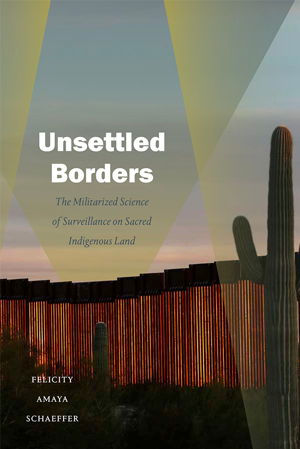
Felicity Amaya Schaeffer
Unsettled Borders: The Militarized Science of Surveillance on Sacred Indigenous Land
Duke University Press, 2022
207 Pages
$26.95
Reviewed by Apurva Gunturu
Felicity Amaya Schaeffer, author of Unsettled Borders, is a professor of feminist studies, critical race and ethnic studies, and Latin American and Latinx studies at the University of California at Santa Cruz. In Unsettled Borders, Schaeffer explores some gaps in existing discourses in Chicanx/Latinx studies, particularly the lack of centered Indigenous struggles and relationships to the land in scholarship concerning cross-border migration and surveillance. Schaeffer structures Unsettled Borders in one introductory and three body chapters, each focusing on the Apache, Tohono O’odham, and Maya peoples’ respective relationships with the Arizona-Mexico border and surveillance. Schaeffer introduces the book with a lengthy discussion of borderland scholarship, focusing on the gaps and contributions of Gloria Anzaldua’s work especially, and with a number of terms that Schaeffer coins in an attempt to fulfill the aforementioned gaps. Major vocabulary terms Schaeffer introduces include ‘Nativevision,’ which refers to United States’ military exploitation of Indigenous peoples’ skills as superior scouters for the purpose of surveillance, and ‘sacredscience,’ which refers to Indigenous methods of knowledge rooted in relationships to the natural environment.
Schaeffer’s research begins with her tracing of military history with Apache peoples, particularly hinging around the Fort Huachuca. Fort Huachuca was originally established by the American military as a camp during the Apache Wars. The camp increasingly turned into a way to secure the Mexican border after Geronimo, a prominent Apache land defender, was tracked and cornered into surrendering. Schaeffer provides an excellent throughline between the extraction of Apache and Indigenous tracking and tracing sciences to both forcibly seize land from Indigenous people and the continuation of this practice to militarize and surveil the border. In narrating US military appropriation of Apache hunting and scouting techniques to gain an upper hand against the Apache nation themselves with a clear attention to detail, Schaeffer highlights this insidiously undervalued piece of military history and its significance to contemporary border patrol tactics, demonstrating that the enforcement of state borders is necessarily also part and parcel to ongoing Indigenous dispossession.
Schaeffer’s weaving of the Department of Homeland Security’s (DHS) employment of Border Patrol to encroach on Tohono O’odham sovereignty in the third chapter of the book was especially compelling. Her description of the employment of surveillance methods (such as drones with names like ‘Apache’ and ‘Blackhawk’), Border Patrol agents, and historic conditions, such as the 1854 Gadsden Purchase that effectively split up Tohono O’odham territory into chunks that could more easily be encroached upon and watched by DHS. Her description of Trump’s 2020 construction of the border wall and its devastation of Tohono O’odham ancestral graves, as well as local flora and fauna, such as the great Saguaro Cactus, was particularly devastating, making the point that the Tohono O’odham peoples are effectively criminalized in their own lands.
At this point, however, I also found Schaeffer’s self-invented vocabulary a somewhat unnecessary contribution to the existing canon of scholarship. In a book aiming to bring Indigenous experiences and perspectives to the forefront of borderlands scholarship, I wondered if it might be more fitting to use existing vocabulary from Indigenous communities, particularly from the Indigenous nations that the book focuses on, thereby more meaningfully legitimizing, centering, and crediting Indigenous ways of knowing. O’odham scholar David Martinez critiques Schaeffer’s term ‘sacredscience’ in his own book review of Unsettled Borders. Martinez notes that the lack of Scheffer’s use of Indigenous words for Indigenous knowledge renders self-coined terms like ‘sacredscience’ meaningless because Schaeffer’s self-coined terms, invented for the purpose of centering Indigenous knowledge, fail to actually connect to the Indigenous knowledge they aim to bring to the academic center (Martínez).
The fourth chapter of Unsettled Borders, titled “From the Eyes of Bees,” attempts to draw a throughline between Maya migration across the US Arizona border, systems of surveillance impacting indigenous peoples migrating across borders, and traditional beekeeping practices as a way of Maya women, especially, practicing and reclaiming autonomy in their ancestral homelands. Schaeffer draws parallels between “swarms of bees” and “swarms of miniaturized surveillance “extending state vision, mobility and communications detecting and preventing “unauthorized movements” across borders. While the chapter overall highlights an interesting intersection of biotechnology and its weaponization in surveillance mechanisms, the subsection on The Erotics of Beekeeping seems to be less about Maya forms of relationality and more an attempt to survey and perhaps even redeem Gloria Anzaldua’s contested characterizations of indigeneity. While Schaeffer eventually returns to speaking about Mayan systems of relationality with nature, especially bees, the interlude in The Erotics of Beekeeping with Anzaldua’s work feels out of place and does not contribute to the overall aim of the book. Maya migration to the United States and their subsequent illegalization is, however, underdeveloped particularly in the legal field, where interpreters and censuses often fail to differentiate the population, resulting in inadequate aid and multiple marginalization. Schaeffer’s attempt to bring attention to the dynamics of Indigenous movement and illegalization through border surveillance is valuable for its acknowledgement of this matter.
Overall, Unsettled Borders could engage with Indigenous constructions of sovereignty further, positioning Indigenous nations as equals to the American empire in balance with the encroachment of border patrol into Indigenous territories. This demand to restructure popular history narratives by acknowledging Indigenous political sovereignty before and after colonial contact by deliberately naming their nationhood, affirmative traditions, and ongoing self-determination is clear in a large body of Native American and Indigenous Studies literature and politics. However, Schaeffer’s book is a respectable attempt to center borderlands discourse, particularly in Latinx and Chicanx studies, around Indigenous peoples and their long history with the construction and subsequent militarization of the US border.

